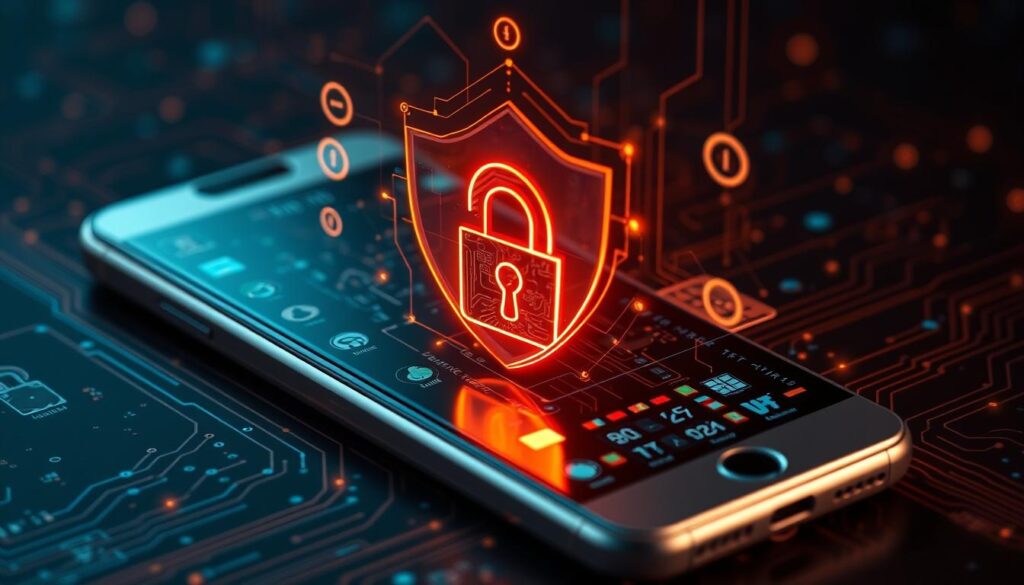In today’s digital world, keeping your personal and professional life safe is key. Cyber threats are on the rise, making a strong cybersecurity plan a must. This plan helps keep your online world safe and secure.
Recent numbers show that 43% of businesses faced a cyberattack last year. This shows how common these threats are. Also, 60% of small to medium-sized businesses fail within six months after a cyber attack. This highlights the importance of strong cybersecurity to protect your online presence.
Cybercrime is expected to cost businesses over $10.5 trillion by 2025. This shows how big the financial hit can be from these threats. So, making cybersecurity a top priority is crucial to avoid these attacks and keep your online space safe.
Key Takeaways
- Implementing comprehensive cybersecurity measures is essential for protecting online presence and ensuring digital security.
- Cybersecurity threats can have devastating effects on individuals and businesses, resulting in significant financial losses and damage to reputation.
- Robust cybersecurity measures can help prevent cyberattacks and protect against data breaches, ensuring online safety and digital security.
- Regular security updates and employee training are critical components of a comprehensive cybersecurity strategy.
- Prioritizing cybersecurity and online safety can help prevent cyberattacks and maintain a secure online presence.
- Investing in cybersecurity measures can help protect businesses from financial losses and reputational damage.
- Staying informed about the latest cybersecurity threats and trends is essential for maintaining a secure online presence and ensuring digital security.
Understanding Modern Cybersecurity Landscape
The world of cybersecurity is always changing, with new dangers popping up every day. As technology gets better, cyber threats get smarter too. It’s key for people and companies to keep up and protect themselves. IT security is vital for stopping data leaks, identity theft, and online scams.
In the last few years, network security threats have grown a lot. Ransomware attacks and cybercriminals using AI are big problems. To fight these, we need strong cybersecurity steps, like keeping social media safe and focusing on data protection.
Current Digital Threats and Risks
Some big digital dangers today are:
- Ransomware attacks
- Cybercriminals using AI and machine learning
- Lack of good security in IoT devices
- Vulnerabilities in electric vehicles and their systems
Evolution of Cyber Attacks
Cyber attacks are getting more complex, thanks to quantum computing and AI. This means we face more cyber threats. It’s crucial for everyone to stay updated and protect themselves.
Impact on Businesses and Individuals
Cyber threats can really hurt businesses and people, causing data breaches, identity theft, and online scams. We must use strong IT security and network security to keep our data safe.
Essential Components of Network Security
Network security is key to keeping data safe. It includes data protection and information security. To fight cyber threats, we need strong security steps. This means managing social media, being careful with online info, and having a solid plan to stop data breaches and identity theft.
A good network access control (NAC) system can stop unauthorized devices or limit their access. This boosts network security. Also, using behavioral analytics tools helps spot odd network behavior. Data loss prevention (DLP) technologies stop employees from sharing sensitive info in risky ways.
- Firewalls, which can be both hardware and software, act as barriers between safe and unsafe networks
- Intrusion prevention systems (IPS), which use global threat intelligence to block malicious activity and track suspect files
- Unified Threat Management (UTM) products, a big part of network security spending
Spending on advanced information security can cut downtime by 45%. Regular security checks and updates lower breach risks. With a data breach costing $4.45 million on average, it’s crucial for companies to focus on network security and data protection. This helps prevent cyber threats and keeps their online presence safe.
Data Protection Strategies in the Digital Age
Data protection is key to keeping information safe from hackers. In today’s world, it’s vital for both people and businesses to protect their data. This helps prevent cyber threats and keeps data safe and available.
To protect data well, we need a few strategies. Encryption methods are important to keep data safe when it’s moving or stored. We use things like SSL/TLS and AES for this. Also, secure data storage solutions help keep data safe from hackers.
Encryption Methods and Implementation
Encryption is a big part of keeping data safe. It can really lower the chance of data breaches. Studies show that encryption can make data 60% safer from breaches.
Secure Data Storage Solutions
Secure storage solutions help keep data safe from hackers. These include cloud storage, external hard drives, and more. They use encryption and access controls to protect data.
It’s also important to back up data regularly. This helps a lot if a cyber-attack happens. Businesses that use backups can get back to normal 20 times faster than those without. By focusing on data protection, we can keep our data safe in the digital world.
Building Strong Authentication Systems
Strong authentication systems are key for IT security, online safety, and cybersecurity. With more cyber threats, we need strong ways to keep data safe. In 2023, over 343 million people were hit by cyberattacks, showing the need for better protection.
A good authentication system uses multi-factor authentication. This means users need more than just a password to get in. For example, they might need a one-time password or use their face. This makes it much harder for hackers to get in.
Some top ways to authenticate include:
- Biometric authentication, like scanning your fingerprint or face
- Token-based authentication, which adds security with one-time passwords
- Behavioral biometrics, which checks how you act to make sure it’s really you
Using strong authentication can cut down on unauthorized access by up to 70%. It’s especially important for people working from home. As cyber threats grow, focusing on IT security, online safety, and cybersecurity is crucial.
Implementing Robust Cybersecurity Measures
Protecting your online presence is key, and strong cybersecurity is essential. Network security plays a big role in this. It means keeping your social media accounts safe and using strong passwords. Also, getting regular security updates helps keep your online world safe.
To keep your data safe, focus on data protection. This includes setting up firewalls, using antivirus software, and keeping your systems updated. By being proactive, you can lower the risk of cyber attacks and keep your personal info secure.
Some numbers show why strong cybersecurity is so important. For instance, 80% of data breaches happen because of weak passwords. Also, companies that train their employees well see a 70% drop in data breaches. By focusing on cybersecurity, you can safeguard your online life and avoid cyber threats.
Here are some important steps for strong cybersecurity:
- Regular security updates to fix weak spots
- Firewalls to block unwanted access
- Antivirus tools to fight off malware
- Multi-Factor Authentication (MFA) to add an extra layer of security
Mobile Device Security Considerations
More people use mobile devices, which means more cyber threats. Cybersecurity is key to keeping these devices safe. A Verizon survey shows 85% of companies have faced mobile security breaches in the last year. This shows how important strong digital security is.
To keep mobile devices safe, you can do a few things:
- Use strong passwords and biometric locks
- Only download apps from trusted sources
- Stay away from public WiFi or use a VPN
- Keep your operating system and security software up to date
A Check Point Research report found 97% of companies have faced mobile threats. Millions of new malware variants target mobile devices every year. This makes online safety crucial. By using strong digital security measures, you can lower the risk of data breaches and keep your information safe.

It’s vital to know the risks of mobile devices and how to avoid them. Understanding cybersecurity, online safety, and digital security helps protect your mobile devices from cyber threats.
Cloud Security and Remote Access Protection
Cloud security is key to keeping data and apps safe in the cloud. It stops unauthorized access and cyber threats. Using strong cloud security, like secure storage and VPNs, helps avoid data breaches and keeps IT systems safe.
Remote access protection is also vital. It lets people safely connect to cloud resources and apps. With secure protocols like SSH and VPN, remote workers can access what they need without risking IT security.
Important things to think about for cloud security and remote access include:
- Implementing multi-factor authentication to prevent unauthorized access
- Using encryption to protect data in transit and at rest
- Regularly updating and patching cloud-based systems and applications
- Monitoring cloud-based resources and applications for suspicious activity
By following these best practices and using strong cloud security and remote access, organizations can keep their IT systems and data safe. This helps protect against cyber threats.
Employee Training and Security Awareness
The digital world is always changing, making cybersecurity more important than ever. With more data breaches and identity theft, it’s key for everyone to focus on digital security. Training employees and raising security awareness are vital for a strong cybersecurity plan.
Good cybersecurity plans include regular training for employees. This can cut data breach risks by up to 70%. Important topics for training include:
- Phishing prevention: teaching how to spot and avoid phishing emails
- Social engineering defense: showing how to resist social engineering attacks
- Security best practices: teaching about strong passwords, safe data storage, and updates
Studies show that 95% of cyber breaches are due to human mistakes. This highlights the need for employee training. By focusing on training, companies can lower data breach risks and keep their online presence safe.
By putting a focus on employee training and awareness, both individuals and companies can protect their digital security. This helps prevent cyber threats and builds a culture of online safety and cybersecurity.
Incident Response and Recovery Planning
When a cybersecurity breach happens, having a solid plan is key. Effective incident response planning means spotting risks, stopping breaches, and knowing how to handle them. It also includes setting up network security like firewalls and data protection through encryption.
Regular backups are crucial. They help lessen damage from cyber-attacks. Stats show, 70% of hit organizations can’t get back to normal for over a week. A strong cybersecurity plan helps avoid long downtime and big losses.

Important steps for incident response planning are:
* Making a formal Incident Response Plan (IRP)
* Doing regular security checks and risk assessments
* Training employees for their roles
* Setting up plans to tell authorities and others if there’s a breach
By being proactive, organizations can keep their online safety, stop threats, and protect their data protection systems.
Conclusion: Maintaining Long-term Digital Security
In today’s digital world, cybersecurity and online safety are key for life. As we use technology more, keeping our digital security safe is crucial. We must stay alert and proactive to avoid cyber threats and protect our personal info.
Good cybersecurity means using strong passwords, protecting data, and training employees. Keeping software up to date and using secure cloud storage helps a lot. As tech gets better, we must keep learning and updating our security to stay safe.
Looking after online safety and digital security is everyone’s job. It helps our communities and society as a whole. By teaching each other and being responsible online, we make the digital world safer for everyone.

